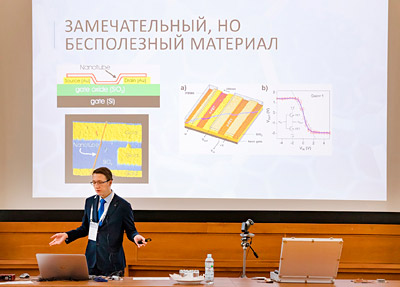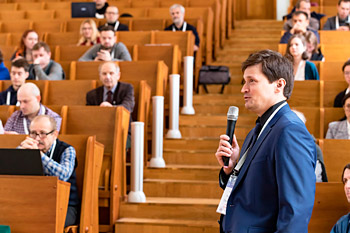
Electronic english version since 2022 |
The newspaper was founded in November 1957
| |
Conferences
Condensed Matter Theory: modern problems
From 17 to 22 October, the International Conference "Modern Problems of Condensed Matter Theory" (CMT-2022) was successfully held at the Bogoliubov Laboratory of Theoretical Physics. The main organizer of the Conference was the Scientific Department of Condensed Matter Theory (SDCMT) of BLTP, Co-chairs were BLTP staff members Michal Gnatich and Vladimir Andreevich Osipov. Alexander Markovich Povolotsky was the Chairman of the Programme Committee.
This is a somewhat new format of holding a conference, since the basic thematic emphasis was on the theoretical aspect of the science of solids, nanoobjects and liquids. Strange as it may seem, previous events of this kind (conferences and scientific meetings) organized by SDCMT had had a mixed format and the reports by theoreticians and experimenters had been delivered in a comparable proportion.
The close proximity of theory and experiment is characteristic of the condensed matter science and explains the strangeness mentioned above. A feature of the materials science is a certain breadth concerning the diversity of these materials, as well as a large amount of properties investigated in them. However, this time the organizers decided to limit not so much the range of objects and phenomena under research, as to introduce restrictions on the theory/experiment categories and even put the word "theory" in the name of the Conference that, however, did not completely protect them from experimental reports.
This time, such scientific centres as St. Petersburg, Moscow and Novosibirsk had a wide representation at the Conference. There were participants from Tomsk, Yekaterinburg, Makhachkala, Samara and of course, Dubna. 58 oral and 15 poster reports were given. Both eminent scientists and young researchers spoke. About a third of all reports were made by BLTP staff members.

The organizers intended to cover all the current theoretical activities in the field of condensed matter research, so they formulated the topic as broadly as possible. The topics announced were as follows: 1) complex materials (high-temperature superconductors, superconducting hybrid structures, fractal structures, functional materials); 2) nanostructures and nanomaterials; 3) models of statistical physics of complex systems; 4) methods of quantum field theory in complex systems.
 |
| BLTP Deputy Director Eugen Anitas talks about the fractal properties of randomly packed disks. |
An overview report corresponding to the first of the above-mentioned areas was given by Professor Michal Gnatic (BLTP). Within the framework of the field model in the three-loop approximation, critical exponents were calculated for the problem of directed percolation. Application of methods in field theory for a completely different problem was presented in the report of Ivan Sergeevich Terekhov (Institute of Nuclear Physics, Novosibirsk) that studied the behavior of the charge density induced by an external field in two-dimensional films - transition metal dichalcogenides. Anatoly Vasilievich Kotikov (BLTP) told the participants how field theory methods allow to calculate the power of the electron-electron interaction in graphene. Of course, there were a range of reports dedicated directly to methodological issues. In this context, it is necessary to note the plenary report of the member of the Programme Committee Professor Yury Mikhailovich Pismak on the development of a general approach for describing the interaction of quantum field systems with extended material objects.
 |
| Artem Romaevich Oganov (Skolkovo) talks about the durability and stability of molecular clusters. |
 |
| Pavel Borisovich Sorokin (MISIS, Moscow) talks about the progress in the field of simulation of carbon nanotubes. |
It is not easy to even briefly describe the whole variety of scientific tasks met using fundamental methods of condensed matter physics which the participants of the Conference spoke about. All reports are noteworthy. However, we restrict ourselves to only a few cases that correspond to general trends, noting in advance the subjectivity of this choice. A member of the Programme Committee Alexander Kimovich Shchekin (St. Petersburg State University) presented a plenary report in which he gave an overview of the scientific results achieved by his team over the past 25 years. Using a range of phenomenological and numerical approaches, he and his employees investigated the phenomenon of disjoining pressure of liquid and gas interlayers between various solid surfaces. A member of the Programme Committee Alexander Vladimirovich Rozhkov (ITPE, Moscow) made a report on insurmountable fundamental difficulties in theoretical prediction of the type of the ground spatially inhomogeneous state in fermionic systems. One of the popular topics was the investigation of the spectrum and properties of magnetic excitations and interphase magnetic boundaries at different dimensions. Several independent reports have been dedicated to these issues. The issues of topology in solids are still relevant, in particular, the report of Zaur Zamirovich Alisultanov (DSU, Makhachkala) was dedicated to Weyl materials.
 |
| The reports of the participants were accompanied by an active discussion. Scientific secretary of the Conference Vsevolod Katkov with a question to the speaker. |
Based on the feedback from participants and listeners, the Conference can be considered a successful one. Its specific "theoretical" emphasis by no means made it less successful than the "thematic" events we had previously held, giving the organizers serious food for thought regarding the future "theoretical" format.
In conclusion, I would like to thank the Directorate of the Bogoliubov Laboratory of Theoretical Physics and the technical staff of the laboratory for their help in organizing the event. Undoubtedly, the organizing committee of CMT-2022 also deserves gratitude: Olga Gennadievna Sadykova, Kirill Vyacheslavovich Kulikov, Nikita Mikhailovich Lebedev, Yury Georgievich Molotkov, Georgy Alibekovich Kalagov, Lukash Mizhishin and Elena Nikolaevna Rusakovich that worked in an exemplary manner. Our Institute has demonstrated its status once again as a centre of high scientific and organizational culture.
Vsevolod KATKOV, Scientific secretary of the Conference,
photo by Elena PUZYNINA